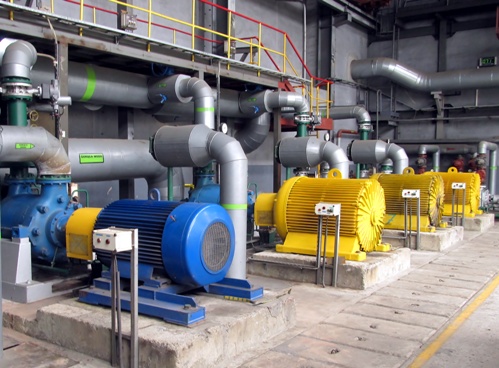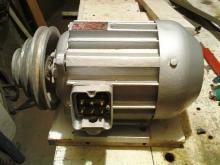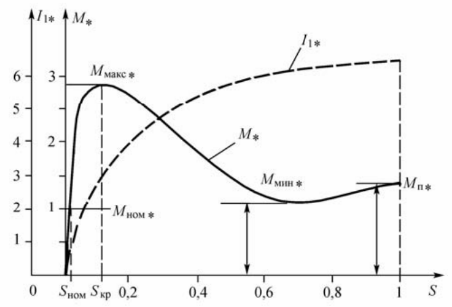Sliding induction motor
As a result of the interaction of the magnetic field with currents in the rotor of the induction motor, a rotating electromagnetic moment is created, which tends to equalize the speed of rotation of the magnetic field of the stator and the rotor.
The difference between the rotational speeds of the magnetic field of the stator and the rotor of an asynchronous motor is characterized by a slip value s = (n1 — n2)/n1, where n1 — synchronous field rotation speed, rpm, n2 — rotor speed of asynchronous motor, rpm. When operating at rated load, slip is usually low, so for an electric motor, for example, with n1 = 1500 rpm, n2 = 1460 rpm, slip is: s = ((1500 — 1460) / 1500) x 100 = 2.7%

Asynchronous engine cannot reach synchronous speed of rotation even three turned off mechanisms, because with it the rotor wires will not intersect with a magnetic field, they will not be induced EMF and there will be no current. The asynchronous torque at s = 0 will be zero.
At the initial moment of starting, a current flows in the rotor windings at the frequency of the network.As the rotor accelerates, the current frequency will be determined in it slip asynchronous motor: f2 = s NS f1, where f1 is the frequency of the current supplied to the stator.
The resistance of the rotor depends on the frequency of the current in it, and the higher the frequency, the greater its inductive resistance. As the rotor inductance increases, the phase shift between the voltage and current in the stator windings increases.
Therefore, when starting asynchronous motors, the power factor is significantly lower than during normal operation. Determine the magnitude of the current equivalent value of the resistance of the electric motor and the applied voltage.
The value of the equivalent resistance of an induction motor with a change in slip changes according to a complex law. With a decrease in the slip in the range 1 — 0.15, the resistance increases, as a rule, no more than 1.5 times, in the range from 0.15 to snoma 5-7 times compared to the initial value at start-up.
Current changes in magnitude are inversely proportional to the change in equivalent resistance. So when it starts to slide on the order of 0.15, the current drops slightly and then rapidly decreases.
The torque of the motor is determined by the magnitude of the magnetic flux, the current and the angular displacement between the EMF and current in the rotor. Each of these quantities, in turn, depends on the slip, therefore, in order to study the operation of asynchronous motors, the dependence of the torque on the slip and the influence of the supplied voltage and frequency on it are established.
Spinning torque may also be determined by the electromagnetic power of the shaft as a ratio of that power to the angular velocity of the rotor. The magnitude of the torque is proportional to the square of the voltage and inversely proportional to the square of the frequency.

ZTorque values for rated voltage are given in electrical machine catalogs. Knowing the minimum torque is necessary when calculating the allowability of starting or self-starting a mechanism with full mechanism load. Therefore, its value for specific calculations must either be determined or obtained from the delivery headquarters.
The magnitude of the maximum value of the torque is determined by the inductive leakage resistance of the stator and the rotor and does not depend on the value of the resistance of the rotor.

Dependence of current and torque on slip
The critical slip is determined by the ratio of the rotor resistance to the equivalent resistance (due to the active resistance of the stator and the inductive resistance of the stator and rotor leakage).
An increase in the active resistance of the rotor alone is accompanied by an increase in the critical slip and a shift of the maximum moment to the region of greater slip (lower rotational speed).In this way, a change in the characteristics of the moments can be achieved.
Changing the slip is possible by increasing the rotor resistance or flux. The first option is possible only for asynchronous motors with a wound rotor (from S = 1 to S = Snom), but not economically. The second option is possible when changing the supply voltage, but only in the direction of reduction. The adjustment range is small as S increases, but at the same time the overload capacity of the induction motor decreases. In terms of efficiency, both options are roughly equivalent.
V asynchronous motor with a phase rotor the change in torque at different slips is done with the help of a resistance introduced in the rotor winding circuit. V squirrel-rotor induction motors, the change in torque can be achieved by using variable parameter motors or using frequency converters.
